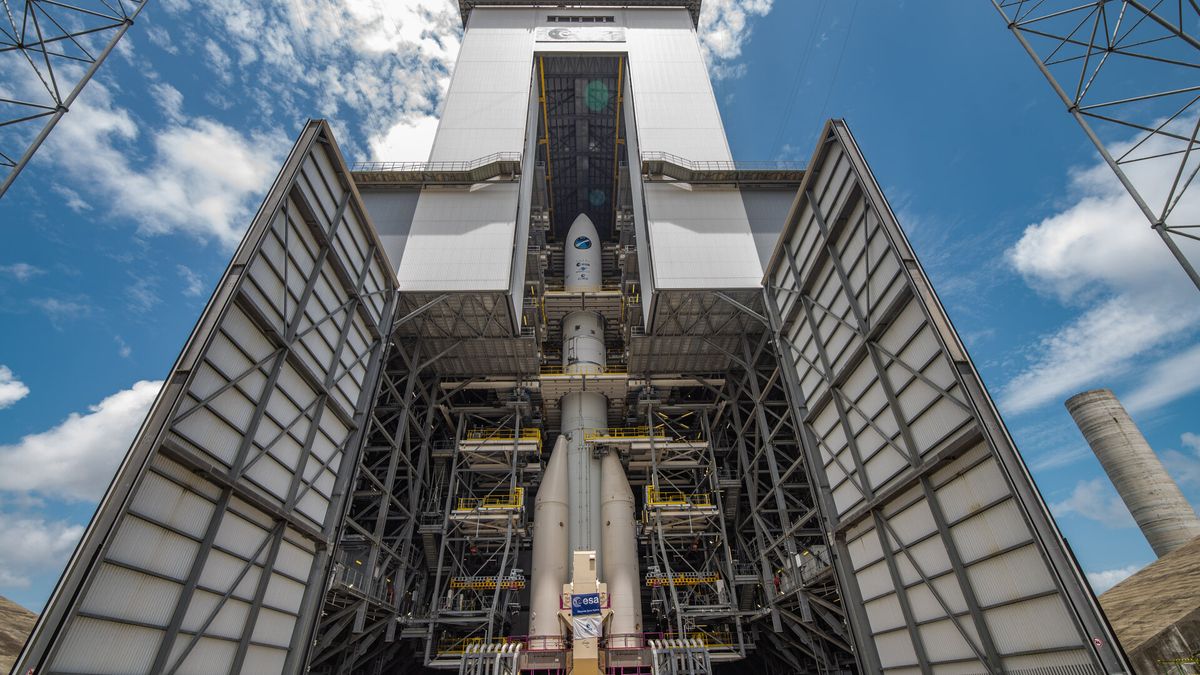Following its wet-dress rehearsal on the launch pad in French Guiana, Europe’s new Ariane 6 rocket is on schedule for its inaugural launch.
The European Space Agency (ESA) announced during a June 25 press conference that the rehearsal was a “full success.” After years-long delays, ESA is confident that their Ariane 6 rocket, deemed the future of Europe’s ability to launch satellites into Earth orbit, will finally get off the ground. ESA and French launch provider Arianespace, which commercially manages the rocket, are preparing for a launch on July 9. The three-hour window opens at 2 p.m. EDT (1800 GMT).
“Of course, we’re still analyzing the data — it might take a few days still. But all we have up to now says that our baby Ariane 6 is working perfectly,” said Lucia Linares, head of strategy and institutional launches at ESA.
The rehearsal took place on June 20. Operators first let the 295-foot (90-meter) rocket stand free on the pad, without support from its gantry, for the first time ever. Then, they cooled the rocket to cryogenic temperatures and pumped it flush with fuel, conducting systems checks all the while, before completely draining it in preparation for the actual launch. ESA will release detailed results from the test later this week, but so far, Ariane 6 appears to be functioning as planned, mission managers said.
“All the verification performed didn’t evidence any anomalous behavior,” said Michel Bonnet, ESA’s principal for Ariane 6’s inaugural flight. “So, based on that, we are still very confident for the [July 9] launch date.”
Related: At long last: Europe’s new Ariane 6 rocket set to debut on July 9
The inaugural launch’s flight plan Ariane 6 up to low Earth orbit (LEO) at an altitude of 320 miles (520 kilometers). This launch will not just be a test flight — once up in orbit, the rocket will release nine cubesats. Also aboard Ariane 6’s Vinci upper stage are four non-orbital experiments, including a device that will test a system for rapidly locating satellites and two capsules that will drop from orbit into the Pacific in order to test if they can re-enter Earth’s atmosphere successfully.
Vinci, however, will burn up. The upper stage can be refired multiple times once in orbit, which can allow a single launch to deploy multiple satellites at different altitudes — and, as is planned for this first flight — deorbit the spacecraft and prevent it from floating endlessly as debris or falling to Earth uncontrolled.
The stakes for Europe’s launch capabilities are high. Ariane 6 is intended to replace the venerable Ariane 5, which took off for the final time last year after 117 launches and 27 years of service. Since then, European launches have been dependent on other — largely American — vehicles.
In these last days before launch, ESA and its partners are keen to emphasize their dissatisfaction with this post-Ariane 5 status quo — and the opportunity for Ariane 6 to change it if successful. “It is an important moment in European space history and for the sovereignty of Europe,” said Carina Laveau, director of space transportation at CNES, France’s national space agency.
Ariane 6 is slated for around 9 to 12 launches per year by 2026. Even before the vehicle’s inaugural flight, both national space agencies and private companies have already booked 30 missions. The highest-profile customer is Amazon, which has so far ordered 18 launches for its planned Kuiper satellite constellation.
This first launch was in fact originally scheduled for 2020, but a battery of technical issues — coupled with disruptions from both COVID-19 and the Russian invasion of Ukraine — have caused repeated delays. The failure of Europe’s fellow Vega C rocket in late 2022 has only raised the stakes for ESA when it comes to this new rocket.
Nonetheless, Ariane 6 officials expressed optimism that any troubles are firmly behind them. “We are ready for launch,” Linares said.











/https://tf-cmsv2-smithsonianmag-media.s3.amazonaws.com/filer_public/34/31/3431771d-41e2-4f97-aed2-c5f1df5295da/gettyimages-1441066266_web.jpg)







Discussion about this post